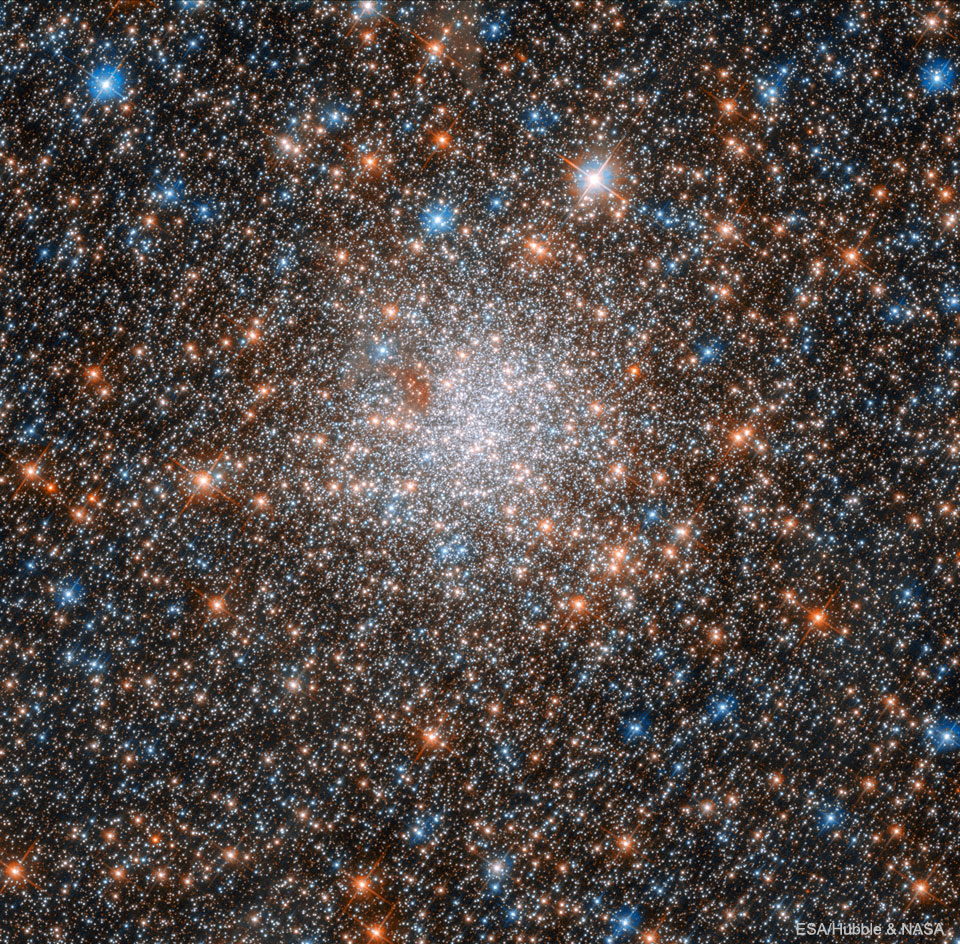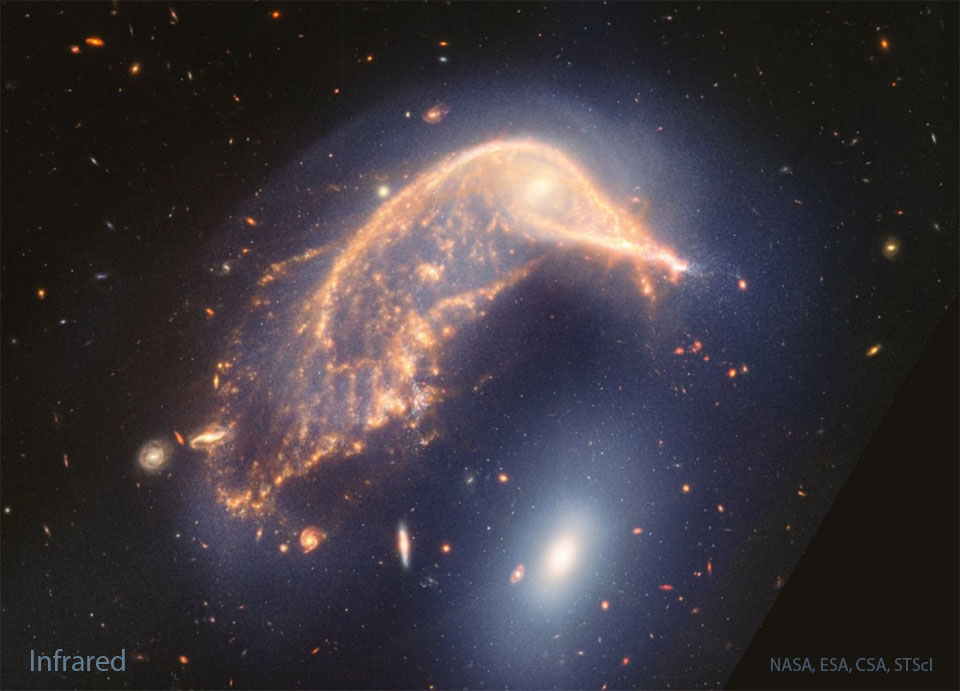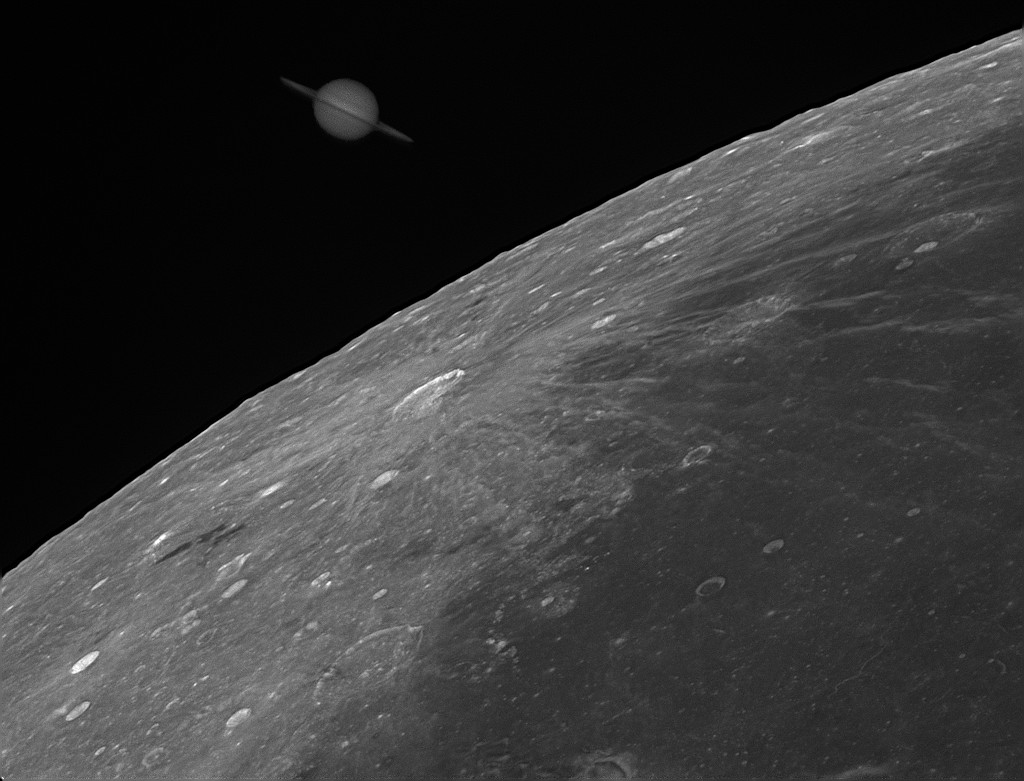Nombre total de pages vues
31/07/2024
SANTé/MEDECINE - Savoir lire les résultats d'une prise de sang - (1 - b) - Les hématies - En cas d'anomalie
30/07/2024
SANTé/MEDECINE - Savoir lire les résultats d'une prise de sang - (1 - a) - Les hématies
ASTRONOMY - Arp 142: Interacting Galaxies from Webb
2024 July 30
Image Credit: NASA, ESA, CSA, STScI; Hubble Rollover Reprocessing & Copyright: Raul Villaverde
Explanation: To some, it looks like a penguin. But to people who study the universe, it is an interesting example of two big galaxies interacting. Just a few hundred million years ago, the upper NGC 2936 was likely a normal spiral galaxy: spinning, creating stars, and minding its own business. Then it got too close to the massive elliptical galaxy NGC 2937, below, and took a dive. Together known as Arp 142, they are featured in this new Webb infrared image, while a visible light Hubble image appears in comparison. NGC 2936 is not only being deflected, but distorted, by this close gravitational interaction. When massive galaxies pass near each other, gas is typically condensed from which new stars form. A young group of stars appears as the nose of the penguin toward the right of the upper galaxy, while in the center of the spiral, bright stars together appear as an eye. Before a billion years, the two galaxies will likely merge into one larger galaxy.
29/07/2024
SANTé/MEDECINE - Antoni van Leeuwenhoek - pionnier de l'observation microscopique
ASTRONOMY - Milky Way over Uluru
Image Credit & Copyright: Max Inwood
Explanation: What's happening above Uluru? A United Nations World Heritage Site, Uluru is an extraordinary 350-meter high mountain in central Australia that rises sharply from nearly flat surroundings. Composed of sandstone, Uluru has slowly formed over the past 300 million years as softer rock eroded away. The Uluru region has been a home to humans for over 22,000 years. Recorded last month, the starry sky above Uluru includes the central band of our Milky Way galaxy, complete with complex dark filaments of dust, bright red emission nebulas, and billions of stars.
2024 July 29
28/07/2024
INVENTIONS DE DEMAIN - Le vaccin qui vous fera écraser

ASTRONOMY - Sun Dance
2024 July 28
Video Credit: NASA, SDO; Processing: Alan Watson via Helioviewer
Explanation: Sometimes, the surface of our Sun seems to dance. In the middle of 2012, for example, NASA's Sun-orbiting Solar Dynamic Observatory spacecraft imaged an impressive prominence that seemed to perform a running dive roll like an acrobatic dancer. The dramatic explosion was captured in ultraviolet light in the featured time-lapse video covering about three hours. A looping magnetic field directed the flow of hot plasma on the Sun. The scale of the dancing prominence is huge -- the entire Earth would easily fit under the flowing arch of hot gas. A quiescent prominence typically lasts about a month and may erupt in a Coronal Mass Ejection (CME), expelling hot gas into the Solar System. The energy mechanism that creates a solar prominence is still a topic of research. Like in 2012, this year the Sun's surface is again quite active and features many filaments and prominences.
27/07/2024
ASTRONOMY - Saturn at the Moon's Edge
2024 July 27
Image Credit & Copyright: Chengcheng Xu
Explanation: Saturn now rises before midnight in planet Earth's sky. On July 24, the naked-eye planet was in close conjunction, close on the sky, to a waning gibbous Moon. But from some locations on planet Earth the ringed gas giant was occulted, disappearing behind the Moon for about an hour from skies over parts of Asia and Africa. Because the Moon and bright planets wander through the sky near the ecliptic plane, such occultation events are not uncommon, but they can be dramatic. In this telescopic view from Nanjing, Jiangsu, China, Saturn is caught moments before its disappearance behind the lunar disk. The snapshot gives the illusion that Saturn hangs just above Glushko crater, a 43 kilometer diameter, young, ray crater near the Moon's western edge. Of course, the Moon is 400 thousand kilometers away, compared to Saturn's distance of 1.4 billion kilometers.
26/07/2024
SANTé/MEDECINE - Gregory Pincus : créateur de la pilule contraceptive
ASTRONOMY - Facing NGC 6946
2024 July 26
Image Credit & Copyright: Roberto Marinoni
Explanation: From our vantage point in the Milky Way Galaxy, we see NGC 6946 face-on. The big, beautiful spiral galaxy is located just 20 million light-years away, behind a veil of foreground dust and stars in the high and far-off constellation Cepheus. In this sharp telescopic portrait, from the core outward the galaxy's colors change from the yellowish light of old stars in the center to young blue star clusters and reddish star forming regions along the loose, fragmented spiral arms. NGC 6946 is also bright in infrared light and rich in gas and dust, exhibiting a high star birth and death rate. In fact, since the early 20th century ten confirmed supernovae, the death explosions of massive stars, were discovered in NGC 6946. Nearly 40,000 light-years across, NGC 6946 is also known as the Fireworks Galaxy.
ASTRONOMY - NGC 1898: Globular Cluster in the Large Magellanic Cloud
025 December 28 NGC 1898: Globular Cluster in the Large Magellanic Cloud Image Credit: ESA / Hubble & NASA Explanation: Jewels don...

-
2022 September 26 All the Water on Planet Earth Illustration Credit: Jack Cook, Adam Nieman, Woods Hole Oceanographic Institution ; Data ...
-
2025 May 11 The Surface of Venus from Venera 14 Image Credit: Soviet Planetary Exploration Program , Venera 14 ; Processing & Copyri...







